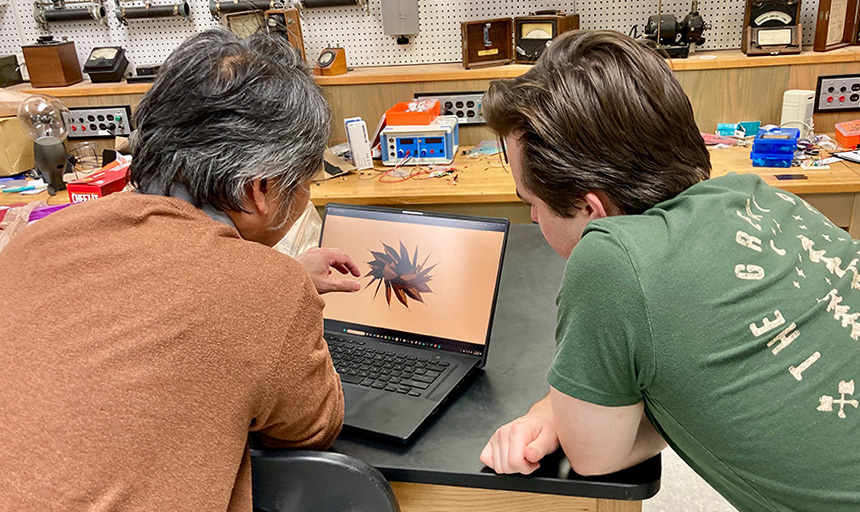
A team of Roanoke College students won second place in the NASA HOEE Starshade Undergraduate Challenge, a nationwide competition that put them to work on a real problem that leading scientists are pursuing.
The award came with a $6,000 prize for the students to put toward research and related travel. The results, announced in late January, were the culmination of months of work by competitors.
Roanoke’s students, led by Bobby Hoye ’24 and Visiting Assistant Professor Truong Le, assembled a diverse group that worked throughout the fall semester to develop its submission. The project demanded late nights right up through finals week to meet the deadline.
“This project really became a passion for us. It meant something to everyone on the team,” said Hoye, a double major in physics and engineering science. “We felt we were in the right spot at the right time to help create something really cool.”
The student challenge, co-sponsored by the American Institute of Physics, invited the nation’s next generation of scientists to apply their skills and creativity to questions about the best structural design for an innovative concept called a “starshade.”
A starshade is a machine being created to help telescope systems record data about faraway exoplanets that orbit large stars. The starshade would be deployed to block out the glare of light from an observed star and enable cameras to capture better images of the exoplanet.
The effort could unlock new information about the mysteries of the universe — including the ever-present question of whether life can be supported on other planets.
Work to perfect the project’s design is ongoing and navigating many complexities. A starshade needs to be strong enough to withstand the perils of deep space, but lightweight and flexible enough to unfurl on its own once deployed in space. It also requires the dexterity to respond to positioning signals from NASA teams back on Earth.
Roanoke’s team, huddled around worktables in Trexler Hall, delved into animated debates about materials ranging from Kevlar to a tape measure’s thin metallic spine in their search for the right blend of strength and flexibility.
Calculations filled the walls day and night. Scaled-down models (one of the competition requirements) were made and remade as ideas were tested.
The NASA-sponsored challenge asked undergraduates to create a conceptual design for a starshade that could be used with Earth’s first ground-based, hybrid observatory to search for exoplanets. The project would create the most powerful planet finders yet designed.
The challenge’s grading had four categories that undergraduates were tasked to do work in: CAD Drawings, Hand Calculations, Report and Physical Model, among other specifics.
The students were supported by a faculty advisor, Le, who teaches physics and astronomy. But the challenge’s ground rules were clear: advisors could offer guidance but couldn’t be fixers for the team. The work and ideas had to spring from the students.
“It was on them,” Le said. “It was a real-life project. It was a real, scientific challenge.”
The team of nine students spanned all four years and various disciplines, such as physics, engineering, computer science and more. “We really felt that our interdisciplinary skills and liberal arts background were part of what made us good candidates for this type of competition,” Hoye said. “This work wasn’t just about being good at physics. It was about being creative and problem-solving. You had to think in 3-D, do simulations and create digital designs.”
Their final work was evaluated by a NASA-led committee at the Hybrid Observatory for Earth-like Exoplanets (HOEE). It was the type of opportunity that few had imagined earning while still an undergraduate.
Addy Littlefield ’26 only had to hear the word NASA when approached about joining the team to make up her mind. The chance to work on the challenge was an incredible, horizon-expanding opportunity.
“It’s something I’ve never done before,” she said. “There are a lot of angles you have to think about. There’s no gravity in that environment. There’s no air. So, materials don’t react the same way they do here. We had to do a lot of research and problem-solving and adapting.”
Professor Karin Saoub, chair of the Math/Computer Science/Physics Department, noted the students and Le tackled this project on top of their normal courses and commitments with no assurance of the outcome. They persevered out of a passion for discovery and learning.
“They should be commended,” she said. “The students took this on and pushed themselves to think creatively, bringing together all the knowledge they gained from their courses here at Roanoke.”
The news that the team’s work had been ranked among the best in the country was electrifying. “There were so many emotions that I felt when I found out,” said Art Duncan ’25, a double major in physics and art history. “Above all, I was just so happy. I started thinking about all the work that everyone did for this project, all the hours put in, and really just how talented and smart all the people who I got to work with on this are.”
To see the team’s efforts recognized with this distinction is huge, he added. “We worked hard and helped each other,” he said. “I’m so thankful for them and for this opportunity.”
The award puts Roanoke’s students alongside peers at the University of Notre Dame and University of Louisiana at Lafayette, which placed first and third, respectively. So impressed was NASA with the top-ranked teams that students also earned an invitation to continue pursuing the project and building a relationship with NASA scientists.
Students who worked on Roanoke’s team, as well as their roles and team committees, included:
Bobby Hoye ’24: Project Lead, 3D Model Lead
Alan Castellon ’24: 3D Model
Tony Saade ’24: 3D Model, Physical Model
Art Duncan ’25: Calculations Lead, Report Lead
Bryan Moctezuma-Vazquez ’25: Physical Model Lead
Dylan Knick ’26: Calculations, Report
Addy Littlefield ’26: Physical Model, Report
Enzo Tagum Fombeno ’27: Calculations
Patrick Brennan ’27: Calculations, Report
-The Salem Times-Register





